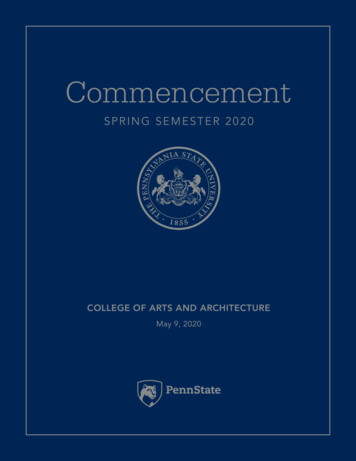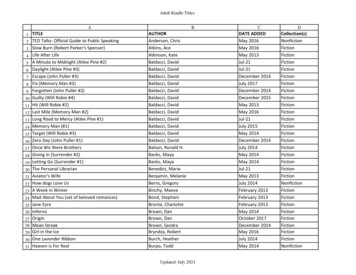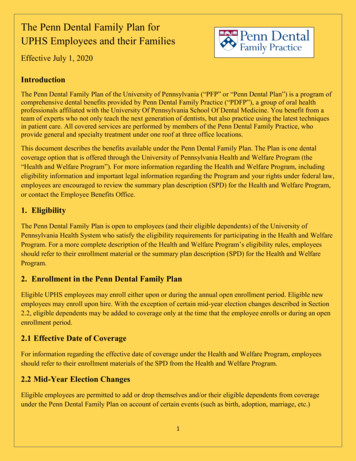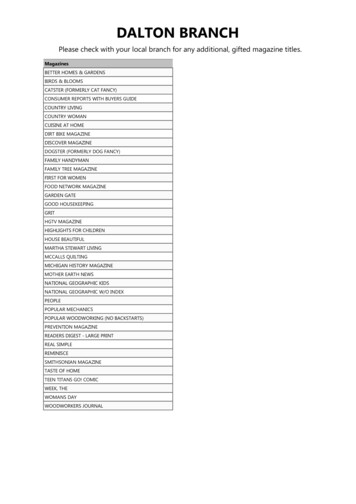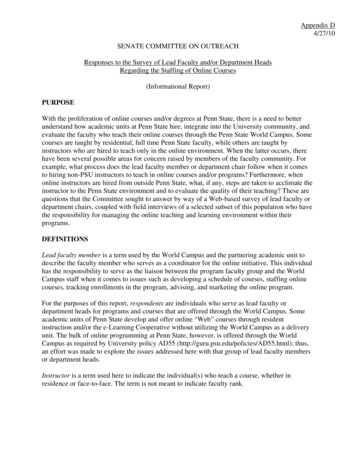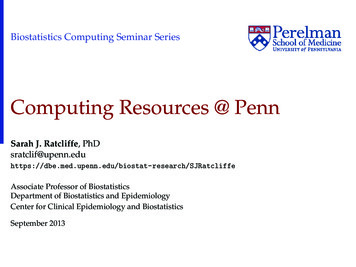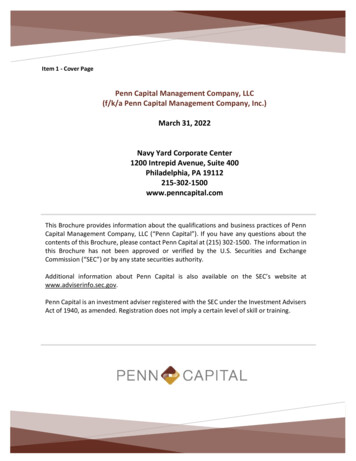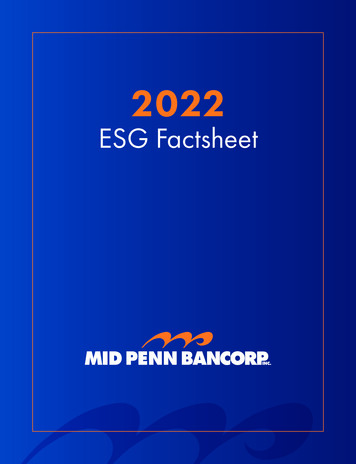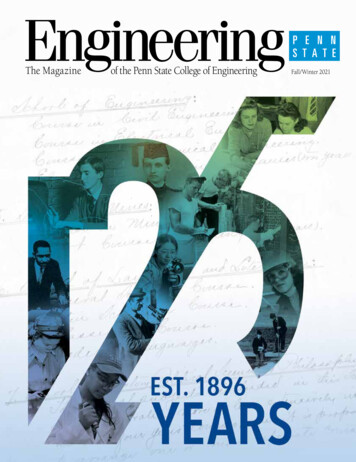
Transcription
The Magazineof the Penn State College of EngineeringFall/Winter 2021
FALL/WINTER 2021Vol. 35, No. 2EDITORS:Megan Lakatos; AshleyWennersHerronWRITERS:Christie Black; Miranda Buckheit;Samantha Chavanic; MariahChuprinski; Erin CassidyHendrick; Andrew Krebs; JeffMulhollem; Tessa M. Pick; JeffRice; Tim Schley; Sarah Small;Gabrielle Stewart; and AshleyWennersHerronContentsGRAPHICS & DESIGN:Kate MyersVIDEO & PHOTOGRAPHY:Chuck Fong; Paul Hazi; TylerHenderson; Kate Myers4MARKETING &COMMUNICATIONS:Andrew KrebsADMINISTRATIVE OFFICERS:President, Eric Barron; ExecutiveVice President and Provost,Nicholas P. Jones; Haroldand Inge Marcus Dean of theCollege of Engineering, JustinSchwartz; Senior Associate Dean,Anthony Atchley; AssociateDean for Education, Peter Butler;Associate Dean for Research,George Lesieutre; AssociateDean for Equity and Inclusion,Tonya Peeples; Associate Deanfor Innovation, Chris Rahn;Assistant Dean for AcademicSupport and Global Programs,Christine Masters; Assistant Deanfor Educational Innovation andAccreditation, Tom LitzingerEngineering Penn State ispublished twice yearly bythe College of EngineeringDepartment of Communications.communications@engr.psu.eduThe Dean’s Message4108Engineering professor namedMicroscopy Society of Americapresident-elect8Newly established director forinternational engineering studentsupport named8Four faculty named to 2020 ‘HighlyCited Researchers’ list9In Memoriam: David Geselowitz,who contributed to artificial heartdevelopment, diesBuilding toward the futureNews & Notes5Over 10 million awarded to PennState for energy center5Penn State to lead 30 millionuniversity research alliance6Trustees approve plans and funds forpart of engineering expansion6Mechanical engineeringbreaks ground on innovativeundergrad lab9In Memoriam: RememberingGifford Albright, first architecturalengineering department head6New industrial engineering space toinvigorate learning97Engineering professor named afellow of the National Academyof InventorsIn Memoriam: Engineering mournsdeath of aerospace engineering’sMichael MicciPrinted on recycled paper. 2021 The Pennsylvania State University. AllRights Reserved. This publication is availablein alternative media on request. Penn Stateis an equal opportunity, affirmative actionemployer, and is committed to providingemployment opportunities to all qualifiedapplicants without regard to race, color,religion, age, sex, sexual orientation,gender identity, national origin, disability orprotected veteran status.7Researchers receive Hall of Fameaward for seminal paper onsmartphone security7Engineering department headelected vice president of ASMInternationalU.Ed. ENG 21-3787Engineering professor namedConsortium to Combat SubstanceAbuse director7Associate director of global programinnovation joins collegeCelebrating 125 Years10 We Are Because We Were16 The founding18 T he first dean22 T he fire and the future24 T he dawn of discovery26 T he educational legacy28 The next steps
engr.psu.eduOn the cover:3038ResearchMaking an ImpactENVIRONMENT30 Membrane nanostructures hold thekey to clean water36 F ind out more ways Penn Stateengineers are making a positivedifference in society31 Growing duckweed to help theChesapeakeStudents31 Using biochar to cleancontaminated wastewater31 Powerful partners: Clean-burningfuel from sun, wind, and seawaterADDITIVE MANUFACTURING32 Modeling waves to uncover3D-printing defects32 Simplifying the complex: Metalcomponent manufacturingARTIFICIAL INTELLIGENCE33 Seeking greater power efficienciesfor AI systems33 Enhancing how humans and AIsystems collaborateHEALTH34 Printing wearable biosensorswithout heat35 Faster sepsis test for reduceddeaths35 Monitoring effectiveness of HIVtreatment at home, not at thehospital38 S tudents’ app improves literacyskills in Kenya39 F irst generation student paves hispath to success39 Making her mark40 C harging ahead through research40 F rom the human body to thehuman mind41 Drawing inspiration from art42 S tudent’s nonprofit nurtureschildrens’ interest in STEM43 Innovating the human experience43 A rchitectural engineering studentselected for ASTM Internationalprogram43 P enn State Society of WomenEngineers wins national award43 E ngineering student chapterrecognized for member dedicationThe college’s 125 anniversarygraphic features faculty andstudents from across the historyof engineering at Penn State. Inthe background are hand-writtenminutes from the Board of Trusteesmeeting on Jan. 3, 1896, whena vote established the School ofEngineering.Email communications@engr.psu.eduto sign up for digital delivery of ourmagazine.Alumni44 Introducing the inaugural 40Under 40 Alumni Award cohort46 Penn State education setscourse for Navy rear admiral46 2 million estate gift to createfaculty chair in aerospaceengineering46 C hemical engineering alumnanamed Woman of the Year inEngineering47 F rom your president: Adaptingto ‘virtual’ as a new reality
Dean’s MessageBuilding towardthe futureCelebrating 125 years‘‘It is the energy of our students, our faculty, our staff, and ouralumni that has propelled us forward for 125 years and willcontinue to do so.”In November, the Penn State College of Engineering began ayearlong celebration of our 125th anniversary with a kickoffevent for students, alumni, faculty, staff, and friends. Althoughour initial vision was for an in-person event earlier in the fall,COVID-19 altered those plans, as it has for so many over thepast year. But the pandemic did not alter our enthusiasm forcommemorating this historic milestone for our college and ourengineering community around the world.Instead of a gathering on campus, we innovated, shifting toa virtual, video-driven anniversary kickoff on Nov. 12. If youhave not watched the videos that premiered on that day—orif you simply want to watch them again —I hope you will visitengineering125.psu.edu to do so.Throughout 2021, our anniversary celebration continues ina variety of ways. For example, on page 44 of this issue ofEngineering Penn State, we are excited to announce ourinaugural class of 40 Under 40 Alumni Award honorees. Theseare individuals who have already made impressive strides intheir careers, communities, and at Penn State. They representthe best of our college and our alumni network.During this anniversary year, we are alsorecognizing the power of philanthropythat opens doors for students, providesinvaluable support for faculty, and movesthe entire college forward. During theyear, those who support engineeringwith a gift of 125 or more will becomea member our 125th AnniversaryEngineering Giving Society and will receivea commemorative pin.Watch the 125th AnniversaryKickoff Event engineering125.psu.edu4E N G I N E E R I N G P E N N S TAT EA third way to celebrate the college’s 125th is via a visit to thePenn State Berkey Creamery on campus or online at creamery.psu.edu/e-chip. Order a cone or gallon of Chocolate E-Chip,the Creamery’s temporarily renamed Scholar’s Chip flavor,which will be available through 2021 following a namingcompetition in the college last fall.Beginning on page 10, I invite you to read more about therich history of our college that we are so excited to celebrate.And join us as we look to the future, guided by a capstone ofimpact and our strategic cornerstones of excellence, equity,social mobility, and sustainability.As you will discover, since our earliest days in the late 1800s,our buildings have changed, our demographics have changed,our funding has changed, and our research has changed. Onething that has not changed is the passion of our people. Fromthe very beginning, the Penn State College of Engineeringhas grown from—and for—people like those highlightedthroughout these pages. It is the energy of our students, ourfaculty, our staff, and our alumni that has propelled us forwardfor 125 years and will continue to do so. Here’s to the past.And here’s to the future.For the glory,Justin SchwartzHarold and Inge MarcusDean of Engineeringdean@engr.psu.edu
News & NotesPenn State to lead 30 million universityresearch allianceThe Department of Defense’s DefenseThreat Reduction Agency has awardeda combined total of 51.1 million totwo university research alliances tocounter threats of destruction, with aspecific focus on improving current anddeveloping future warfighter technology.Penn State is leading the Interaction ofIonizing Radiation with Matter UniversityResearch Alliance, which was awarded 30 million for the next five years, withthe potential of extending the alliancefor a total of nine years and 54 millionof funding with additional fundingopportunities available.Over 10 million awarded to Penn Statefor energy centerPenn State has received more than 10 million from the U.S.Department of Energy as an Energy Frontier Research Center Award.According to principal investigator and center director Susan TrolierMcKinstry, Evan Pugh University Professor and the Steward S. FlaschenProfessor of Ceramic Science and Engineering and professor ofelectrical engineering, the research in the center will focus on discoveryof new ferroelectric materials, probing the origins of ferroelectricity,developing tools to control the functional properties, growing tailoredferroelectrics at low temperatures, integrating the new materials into avariety of memory devices, and developing processes that allow thesematerials to be stacked in 3D memory arrays.The leadership team includes associate director Vijay Narayanan, A.Robert Noll Chair of Electrical Engineering and Computer Science,and thrust leaders Jon-Paul Maria, professor of materials science andengineering, and Tom Jackson, Robert E. Kirby Chair Professor ofElectrical Engineering. Other faculty from the college include SaptarshiDas, engineering science and mechanics, and Abhronil Sengupta,electrical engineering.Institutional partners include Sandia National Laboratory, Oak RidgeNational Laboratory, Purdue University, University of Pennsylvania, andUniversity of Virginia.The four-year grant is funded between 10 million and 15 million withpossibility of renewal.Led by Doug Wolfe, head of theDepartment of Metals, Ceramics, andCoatings Processing in the AppliedResearch Laboratory (ARL), professorof materials science and engineering,engineering science and mechanics, andnuclear engineering by courtesy, PennState’s efforts are focused in ARL andthe Colleges of Engineering and Earthand Mineral Sciences. The alliance alsoincludes the University of Michigan,Massachusetts Institute of Technology,and University of Florida, and eightother universities and several nationallaboratories and industry partners.Primary Penn State contributors includeMeghan Flannery Hayes, head of theDepartment of Complex SystemsMonitoring at ARL; Marek Flaska andAzaree Lintereur, assistant professorsof nuclear engineering; Aman Haque,professor of mechanical engineering andengineering science and mechanics; andSaptarshi Das, assistant professor ofengineering science and mechanics.The team is investigating how ionizingradiation interacts with matter. Accordingto Wolfe, this research could lead tohigher-resolution radiation detectorscapable of identifying dirty bombs orconcealed radiation materials.FA L L / W I N T E R 2 0 2 15
News & NotesTransforming our footprinton campus bit.ly/engr-west2Renderings of West 2 (main photo), ME Knowledge Commons (top right), and Leonhard Commons (bottom right).Trustees approve plans and funds for part of engineering expansionThe Board of Trustees approvedfinal design plans and authorizedexpenditures for a new research andteaching building near the western edgeof the University Park campus.be built adjacent to the West CampusParking Deck, which is currently underconstruction to the west of LeonhardBuilding and the Earth and EngineeringSciences Building.Currently known as West 2, the buildingwill provide approximately 105,000gross square feet to be used as flexibleclassrooms, multi-use design studios,“cornerstone to capstone” makerspaces, a high-bay research lab, facultyoffices, and research cores to benefit allCollege of Engineering disciplines. It willConstruction of West 2, which began inOctober 2020, is one aspect of a broaderproposed, multi-phase facilities masterplan for the college that includes inphase one construction of a second newbuilding to the west of North AthertonStreet, renovations to Sackett Building,and the demolition of Hammond“As we transform our footprint oncampus, we will be even better equippedto recruit and retain the best faculty,researchers, and students, allowing us tohave a long-lasting impact as one of thebest engineering colleges with strongeducational programs and advancedresearch capabilities,” Justin Schwartz,Harold and Inge Marcus Dean ofEngineering, said.Mechanical engineering breaks ground oninnovative undergrad labNew industrial engineering space to invigoratelearningTo fully reimagine its undergraduate lab experience, theDepartment of Mechanical Engineering (ME) broke ground on a5,700-square-foot space in the basement of the Reber Building.The Harold and Inge Marcus Department of Industrial andManufacturing Engineering is adding a new student-centeredspace within the Leonhard Building.The ME Knowledge Lab will include a collaborative designhub; 3D printers and a light makerspace; lab stations, includingcharacterization devices for wind turbines, gas turbines, batterycells, and materials; a virtual reality learning site; and anautonomous vehicles lab.The 6,200-square-foot Leonhard Commons will be equippedwith group study rooms, private meeting rooms outfitted withmonitors and video conferencing technology, computer deskclusters designed by students, a classroom, gathering hub,recharge zone, printing corner, an open study area with whiteboards and projector screens, and sectional furniture that can bemoved to provide room for lectures and events.Watch the video to learn more: bit.ly/me-lab6Building along College Avenue and theEngineering Units behind Hammond.E N G I N E E R I N G P E N N S TAT E
News & NotesEngineering department head electedvice president of ASM InternationalJudith Todd, head of theDepartment of EngineeringScience and Mechanics,was recently electedvice president of ASMInternational.Engineeringprofessor nameda fellow of theNational Academyof InventorsVijaykrishnan Narayanan, A.Robert Noll Chair of ElectricalEngineering and ComputerScience, has been named a 2020fellow of the National Academy ofInventors (NAI).NAI fellows are selected for having“demonstrated a highly prolificspirit of innovation in creating orfacilitating outstanding inventionsthat have made a tangible impacton the quality of life, economicdevelopment, and the welfare ofsociety.”Narayanan will be inducted at the2021 Fellows Induction Ceremonyat the Tenth Annual Meeting of theNational Academy of Inventors inJune 2021 in Tampa, Florida.The lead author of the paper,“TaintDroid: An InformationFlow Tracking System forRealtime Privacy Monitoringon Smartphones,” was WilliamEnck, associate professor in theDepartment of Computer Scienceat North Carolina State University,who was a Penn State graduatestudent at the time of the paper’spublication. He was advised by coauthor Patrick McDaniel, William L.Engineering professor namedConsortium to Combat SubstanceAbuse directorPaul Griffin, professor ofindustrial engineering, willbecome interim director ofthe Consortium to CombatSubstance Abuse (CCSA)beginning in summer 2021.Griffin, an expert in healthsystems engineering, is already a co-fundedfaculty member of CCSA within the SocialScience Research Institute.Researchers receiveHall of Fame awardfor seminal paper onsmartphone securityA multi-institution team ofresearchers received a Hall of FameAward from the Association forComputing Machinery’s SpecialInterest Group on OperatingSystems (SIGOPS) for their 2010paper that was the first to exposethe ways in which smartphoneapplications use personal data.As vice president, Todd hopes to continueworking with various groups to help ASMInternational become the preferred choicefor individuals interested in materials. Shealso hopes to support ASM International inits mission to become a recognized worldleader for materials information by developinginternational chapters, strategic collaborations,and partnerships to provide members withvalued resources.Griffin is eager to lead CCSA by helping toidentify where engineering and technologyresearchers can help fill in the gaps for socialscientists.Weiss Chair in Information andCommunications Technology in theSchool of Electrical Engineeringand Computer Science.This paper specifically was chosenby the SIGOPS award committeebecause it “sparked an importantresearch agenda on smartphoneprivacy that continues to thisday” by documenting “dozens ofpotential leaks of sensitive andprivate information” in smartphoneapplications.McDaniel’s work has led to manyaccolades, most recently beingnamed a fellow of the AmericanAssociation for the Advancementof Science.Associate director of globalprogram innovation joins collegeKati Csoman has beennamed associate directorof global programinnovation in the Officeof Global EngineeringEngagement in theCollege of Engineering—anewly established position that will drive theexpansion and enhancement of internationalengineering opportunities for students.As the associate director of global programinnovation, Csoman will work closely withengineering faculty to advance globalengagement, lead innovation in faculty-ledabroad courses, and further advance thedevelopment of global competencies forengineering students. She also hopes tointegrate virtual components into globalprograms in response to the currentlimitations on travel during the pandemic.FA L L / W I N T E R 2 0 2 17
News & NotesEngineering professor namedMicroscopy Society of Americapresident-electDeborah Kelly, HuckChair in MolecularBiophysics, professor ofbiomedical engineering,and director of thePenn State Center forStructural Oncology,was elected president of the MicroscopySociety of America (MSA). Her three-yearcommitment as first president-elect, thenpresident, then past president, began inJanuary.Four faculty named to 2020 ‘HighlyCited Researchers’ listFour faculty members were recognized as Highly Cited Researchersby the Web of Science Group:As president, Kelly plans to continue toelevate the society’s mission through socialmedia engagement and cross-pollinationefforts with other national societies. Shewill also work to attract and retain moreunderrepresented scientists to MSA.Newly established director forinternational engineering studentsupport namedMelika Sharifironizi hasbeen named director forinternational engineeringprograms—a newlyestablished joint positionwith the college’s Centerfor Engineering Outreachand Inclusion (CEOI) and Ken and MaryAlice Lindquist Department of NuclearEngineering.As part of CEOI, Sharifironizi will help thecollege attend to equity issues relatedto the national origins of its students.Her work will advance student-focusedinitiatives—including recruitment andretention, academic success, social andcultural climate, and job placementprograms.As part of the nuclear engineeringdepartment, Sharifironizi will look toestablish sustainable energy systemscourses with service-learning researchprojects and support radiochemistry andnuclear chemistry research and academicsupport. This includes assisting withsummer undergraduate opportunities forgender inclusion in nuclear engineering.Long-Qing ChenHamer Professor of Materials Science andEngineering, professor of engineering scienceand mechanics, and professor of mathematicsChen, named to the list for the thirdconsecutive year, works to understand,predict, and design materials microstructures,with a focus on their properties and evolutionduring the processing of materials.Bruce LoganKappe Professor of EnvironmentalEngineering and Evan Pugh UniversityProfessor in EngineeringLogan, named to the list for the seventhconsecutive year, focuses on developing newrenewable energy technologies to achieve anenergy sustainable water infrastructure.Şahin K. ÖzdemirAssociate professor of engineering scienceand mechanicsÖzdemir, named to the list for the secondconsecutive year, focuses on optical physicsand quantum photonics, as well as theapplication of this understanding to newtechnologies.Donghai WangProfessor of mechanical engineering andchemical engineeringWang, named to the list for the thirdconsecutive year, develops nanomaterials forclean energy technologies, such as siliconbased anodes in rechargeable lithium ionbatteries.Don’t miss a thing .For the latest news and information from the College ofEngineering, including alumni spotlights, research from ourfaculty and graduate students, and more, visit engr.psu.eduand follow us on social SUEngineering@penn-state-engineering
News & NotesIn MemoriamDavid Geselowitz, distinguishedalumni professor emeritus ofbioengineering and professor emeritusof medicine, died on Aug. 22 at age 90.Geselowitz received his bachelor’s,master’s, and doctoral degreesin electrical engineering from theUniversity of Pennsylvania.David Geselowitz, whocontributed to artificialheart development, diesAfter obtaining his doctorate degree,Geselowitz joined the University ofPennsylvania faculty and founded oneof the nation’s first doctoral programsin biomedical engineering. In 1971,he moved to Penn State to implementa pioneering graduate program inbioengineering. In 1974, the programwas launched under Geselowitz’sleadership and became the University’sGifford “Giff” Albright, the first headof the Department of ArchitecturalEngineering (AE), died on Dec. 30,in State College. He was 89 years old.Remembering GiffordAlbright, first architecturalengineering department headIn 1953, Albright became thefirst graduate of the University’srestructured five-year bachelor ofarchitectural engineering degreeprogram. After earning his masterof science in building engineeringfrom the Massachusetts Institute ofTechnology in 1955 and serving in theUnited States Navy Civil EngineeringCorps, Albright returned to Penn Stateas the founding head of the newlyre-established AE department in 1962.Michael Micci, professor of aerospaceengineering, died on Sept. 21, in StateCollege after an eight-month battlewith cancer. He was 66 years old.Engineering mourns deathof aerospace engineering’sMichael MicciMicci earned his bachelor of scienceand master of science in aerospaceengineering from the University ofIllinois at Urbana–Champaign and hisdoctoral degree from the Departmentof Mechanical and AerospaceEngineering at Princeton University.In 1981, Micci joined the Departmentof Aerospace Engineering as anassistant professor. He was promotedfirst Intercollege Graduate DegreeProgram, with faculty from theColleges of Engineering, Medicine,Science, and Health and HumanDevelopment.Working closely with William Pierce,a surgeon at the Milton S. HersheyMedical Center, Geselowitz supervisedthe development of an artificial heart.In 1976, to international acclaim, apneumatic left ventricular assist devicewas successfully implanted in a humanpatient. Still used today, the devicehelps keep patients alive until a hearttransplant can be performed. Thistechnology eventually evolved intoa full artificial heart, which is still indevelopment at Penn State.He held the title until 1983, when hestepped down and continued to serveas a professor until he retired in 1991.Albright specifically envisioned acomputer operating system thatallowed individuals in differentdisciplines to quickly converge onthe conception and design of abuilding with the same goal of specificperformance criteria. The resultingprogram, called Project Man-MachineSystem for the Optimum Design andConstruction of Buildings (ProjectMODCON), also led to the nation’s firstcourse in integrated building systemsbased on computer applications.to associate professor in 1988 andfull professor in 1998. He taughtaerospace topics ranging fromdynamics and control to programmingto spacecraft environments. Asa genuine rocket scientist, Miccispecialized in all forms of rocketpropulsion.In 1994, Micci was the first personto use molecular dynamics tosimulate supercritical atomizationand vaporization as it occurs in highperformance liquid rocket engines.FA L L / W I N T E R 2 0 2 19
We AreBECAUSEWe WereTracing 125-plus years of engineering history at Penn Stateby Andrew Krebs
engineering125.psu.eduThis issue of Engineering Penn State commemorates the 125th anniversary of the founding ofthe Penn State College of Engineering. The vibrancy and impact for which the college is knowntoday threads back through history, not only to the decision by the Board of Trustees in 1896 toorganize The Pennsylvania State College into seven distinct schools, one of which was the School ofEngineering, but also to countless other decisions, moments, achievements, and individuals thatcollectively form the fabric of engineering at Penn State in 2021.Engineering through the years1896The Board of Trustees makesit officialOn Jan. 3, engineering joins sixother newly formed schools withinThe Pennsylvania State College.1900We Are No. 10Demand grows steadily in the earlyyears of the School of Engineering.By the turn of the century, PennState ranks 10th in the nation forthe number of undergraduateengineering students enrolled.1909Engineering experiment stationbroadens the school’s focusDean John Price Jackson pushes theneed to use theoretical knowledgegained in the classroom andlaboratory to solve the practicalproblems of industry.1918School responds to world at warPenn State and hundreds of othercolleges and universities providetechnical training for enlisted militarypersonnel via six- and eight-weekcourses. During the course of thewar the school gives instruction to2,500 troops.192919551945Designing a new home onCollege AvenueHowell Lewis Shay and Associates ofPhiladelphia design the 5.9 millionHammond Building, a stone andmetal panel structure of about600 feet in length, which isdedicated in 1960.The school benefits PennsylvaniansBy the end of the 1920s, theschool’s Department of EngineeringExtension had given instruction onvirtually every engineering topicto more than 30,000 Pennsylvaniaresidents.The birth of Ordnance ResearchLaboratory (ORL)The Navy transfers developmentand testing of underwater weaponryfrom Harvard to the school. ORLeventually becomes the AppliedResearch Laboratory at Penn State.Acknowledgements: The College of Engineering atPenn State: A Century in the Land-Grant Tradition, writtenby Michael Bezilla and published by the Penn StateUniversity Press in 1996, served as an invaluable guide tothe history of the college prior to and throughout its firstcentury. Special thanks also to the Eberly Family SpecialCollections Library and Penn State University Libraries.Left page: Main Engineering Building (early 1900s).Right page, top: The “Good Roads” train (1910s),Bottom: Rendering of Hammond Building, Kunkle Lounge,and Sackett Building.Engineering powers upDesigned by William M. Breazeale,the reactor on the eastern edgeof the Penn State campus reachescriticality, the point at which a selfsustaining reaction occurs.1957
1968Projecting engineering demandThe American Society forEngineering Education urgeseducators and the profession “tomake every effort to attract anincreasing number of studentsto engineering at both theundergraduate and graduate level.”1980Among the largestWith more than 7,000undergraduates, the college hasone of the largest enrollments inthe nation.1989Working to expand theengineering communityThe new Women in EngineeringProgram, along with the MinorityEngineering Program from a fewyears earlier, adopt outreachstrategies to attract more womenand underrepresented students intoengineering.Top: Students working together (1980s).Bottom: Garfield Thomas Water Tunnelconstruction (1950s).1976The helping heartA team of researchers in the Collegesof Engineering and Medicineintroduce the Penn State Heart-AssistPump, the first device of its kind.12E N G I N E E R I N G P E N N S TAT E1996An engineering landmarkThe American Society of MechanicalEngineers recognizes the GarfieldThomas Water Tunnel, which beganoperating in 1950, as a nationalhistoric mechanical engineeringlandmark. Today, the tunnel is partof the Penn State Applied ResearchLaboratory and serves as theprincipal experimental hydrodynamicresearch facility for the U.S. Navy.2012The Learning Factory recognizedThe National Academy ofEngineering recognizes theBernard M. Gordon LearningFactory, established in 1995, asone of 29 programs “infusingreal-world experiences intoengineering education.”
2018A master plan for the futurePenn State engages with the firm Payetteto develop a framework for College ofEngineering capital projects over 10 years.The master plan promises to reshape thecollege and its footprint on campus.2020Breaking new groundConstruction begins on the first of two newplanned buildings on West Campus, thestart of the college’s facilities master planimplementation.Top: The 10-year facilities master plan for the College of Engineering includes several newbuildings on West Campus. Bottom: A reimagining of the current engineering footprintadjacent to the Mall and along College Avenue.FA L L / W I N T E R 2 0 2 113
FACES OF ENGINEERING1890s-1930s14E N G I N E E R I N G P E N N S TAT E
Left page: Electrical engineering students (1890s). Right page, clockwise from top: Studentinspection trip to D.C. (1910s), Electrical engineering student (1800s), Civil engineering camp(1920s), Working in the Foundry (1900s), Architectural engineering class (1920s), Students in thetelephone laboratory (1920s).FA L L / W I N T E R 2 0 2 115
THE FOUNDINGThree days into the start of thenew year in 1896, the Board ofTrustees for the Pennsylvania StateCollege gathered in Harrisburg forits
4 ENGINEERING PENN STATE Watch the 125th Anniversary Kickoff Event engineering125.psu.edu In November, the Penn State College of Engineering began a yearlong celebration of our 125th anniversary with a kickoff event for students, alumni, faculty, staff, and friends. Although our initial vision was for an in-person event earlier in the fall,



